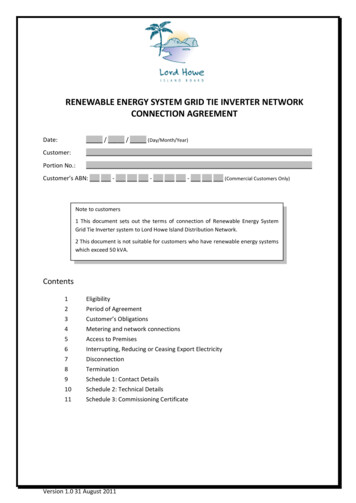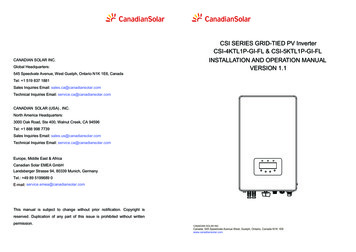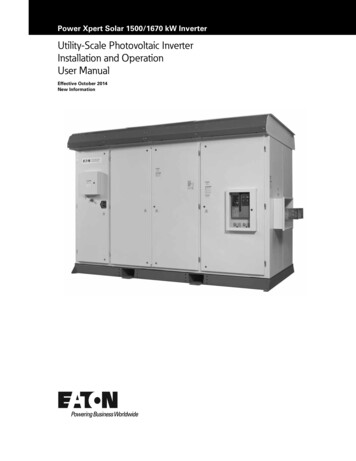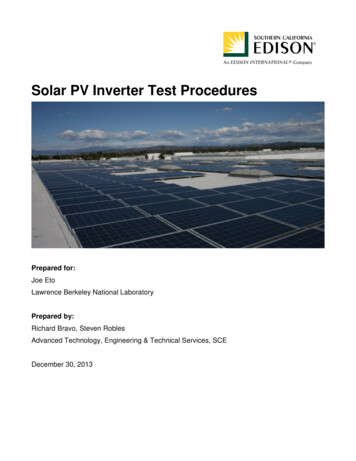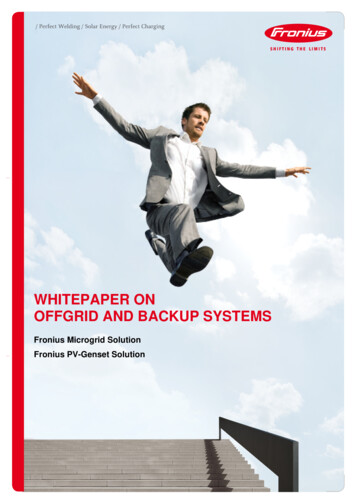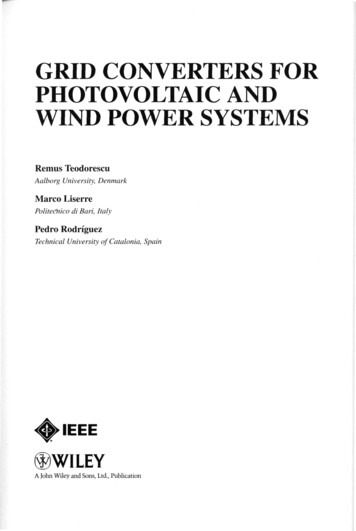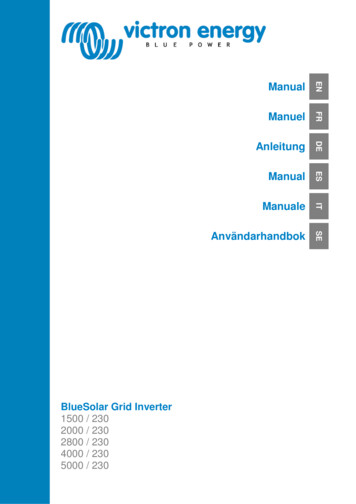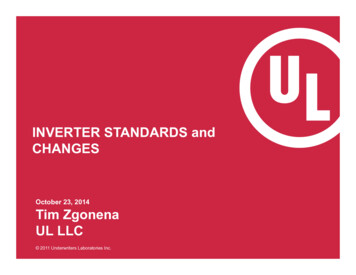
Transcription
INVERTER STANDARDS andCHANGESOctober 23, 2014Tim ZgonenaUL LLC 2011 Underwriters Laboratories Inc.
UL 1741 Covers Power Conversion and ProtectionEquipment for the Following Types of DR products:Photovoltaics, PVFuel CellsMicro-turbinesWind and Hydro TurbinesEngine Generator SetUtility Interactive InvertersStand Alone InvertersMulti-Mode InvertersAC ModulesCharge ControllersPV Balance of Systems,Combiner Boxes, GFDIs, etc2
US Adoption of IEC 62109-1 and -2 The US is moving to adopt IEC 62109 UL was granted rights to develop UL62109-1& IEC 62109-2 Developed International HarmonizationCommittee (IHC) Published UL62109-1 UL62109-2 Q1 2015 Focus on minimizing national differences Through the harmonization process we haveidentified several revisions and points ofclarification for the IEC standards
New International Based PV ElectronicsCertification Option for the USAUL 62109, Safety of power converters for use in photovoltaic powersystems, was published on July 18th of 2014 and is now the USharmonized version of the international PV power conversionstandard IEC 62109. IEC 62109 was born out of UL1741 and wasexpanded / updated to address cutting edge safety aspects of PVpower conversion equipment. IEC 62109 is being adopted aroundthe world and is the basis for harmonized international safetycertifications. UL 62109, like UL1741, provides a means todetermine that PV inverters and other PV electronics: Are constructed per common industry requirementsCan be installed in accordance with US Codes.Operated per industry specific required ratingsPerform safely under rated normal worst case conditionsPerform safely under foreseeable abnormal operating conditionsand failure modes.
UL1741 and UL 62109Look very different but are very similar and addressthe same types of hazards.62109 was written to expand upon UL1741 and fillin known gaps.1741 covers all forms of DG sources.62109’s scope is limited to PV,but it could easily be applied toinverters with other input source flavors.6
IEC 62109 Safety of Power Convertersfor use in Photovoltaic Power SystemsPart 1: General RequirementsIEC 62109-1 – Started NWIP life as a copy of UL1741. Wasdeveloped over many years, with considerable effort and itwas published in April 2010. Shortly after EN62109-1 wasadopted and published by CENELEC.IEC 62109-2 - Specific to inverters Published June 2011and is being adopted around the world.
What Does IEC 62109-2 Cover?Requirements for PV Inverters,Grid Tied, Utility Interactive - Products that operate inparallel with or backfeed power to the utility grid tosupply common loads.Stand Alone - Products that supply power to loadsindependent of the utility grid.Multimode - Products that can operate in both utilityinteractive and stand-alone modes in case of utilityfailure.Page8
IEC 62109-2 PV Inverter SpecificRequirementsIEC 62109-2 addresses the requirements forinverter specific safety functions: PV Ground Fault Protection Power Quality THD, DC injection, Voltage and frequency control Array and system isolation protection Markings Documentation9
IEC 62109 and UL1741Note: The scope of UL 1741 includes sections that arenot yet published in IEC 62109, such as: PV charge controllers Requirements for other renewable energysources like fuel cells, rotating machines, etc, Grid interconnection systems equipment. Some of these are presently not being consideredfor addition to the IEC 62109 series
Potential Future State for UL1741 and UL62109UL1741 Non PV invertersconverters andinterconnectionequipmentUL62109-1 & 62109-2ReferenceExcluded from Scope Grid Interconnect Grid InterconnectReplace PVrequirements withreference to 62109-1and -2 for PV invertersand PV GFDIsReferenceMove requirementsPV Power conversionequipmentReferenceUL62109-A? Place HolderEquipment without an IEC standardPV charge controllersPV AFCICombiner boxesAC Modules11
Benefits of Harmonized InternationalSafety StandardOne base document for much more consistentcertificationsNational differences are easier to address thannational standardsFewer revisions to track and comply withReduced engineering time to prepare forcertificationsReduced certification time reduces time to marketSignificant certification cost savings
Northbrook, IL, February 24, 2014 –UL (Underwriters Laboratories) announces they haveachieved IEC 62109-1 and 62109-2 Certified Body TestingLab (CBTL) status for inverter products.With this internationally recognized testing accreditation, UL can provideinternationally accepted market access reports, known as aCertification Body (CB) report, to inverter manufacturers. The invertercan be evaluated to the standard for the US and/or another market(s)in one project. The UL Mark can then be applied to the certified productand sold in the US and / or a CB report created and provided forproduct sold into international markets. UL will provide both thenecessary safety testing and/or testing for grid interconnection tospecified national requirementsIn addition to our leadership in the development of international andnational power conversion standards, UL’s PV inverter testinglaboratories in Greater China, Germany, the United States and Italyprovide conformity services including safety, performance, and EMCtesting, for global markets.
New California Rule 21
Phase 1 Autonomous FunctionsFunctionDescription12Anti-Islanding ProtectionLow/High Voltage Ride-ThroughModified L/HVRT and L/HFRT settings.Defines “Stay Connected Until” and“Disconnect By” areas.3Low/High Frequency RideThroughExpands frequency range for remainingconnected over WECC settings45Dynamic Volt/Var OperationsRamp Rates67Fixed Power FactorReconnect by “Soft Start”Default Volt-Var curve with dead-bandEstablishes default ramp up and ramp downrates for:a. Normalb. Emergencyc. Soft disconnectNew allowed PF ranges.Ramp up and/or random start time after 15seconds of V&F in range.
Phase 2 CommunicationRelated FunctionsFunctionDescription1ControlAdjustment of default parametersassociated with the functionsidentified in Phase 1 above.2MonitoringAbility to read the identified set ofparameters (see SWIG document)3FunctionalityAbility to download new firmwareupgradeabilityto inverter4Emergency direct controlAbility to directly set functions
Future Phase 3 FunctionsNot yet defined. Noted possibilities include:Emergency AlarmsCurrent statusCommanded Max power limitConnect/disconnectOptional/alternative settings configurationsSelf-test of new softwareDynamic frequency-wattDynamic volt-varPreset Max power limitVolt-watt curvesSet power level
Need to Clearly DifferentiateThe differences between utility interactive generationproducts. Utility Interactive, Grid Support Utility Interactive Special Purpose Utility Interactive products.Clearly define product functions, ratings and requirementcompliance within the product markings, ratings, manual,certification documentation and new certificationcategories.
Utility Interactive pecial Purpose UtilityInteractiveGrid Support UtilityInteractiveStandard(s)TraditionalIEEE 1547 andIEEE 1547.1Complies with all features,ratings and requirementsdefined by inverter mfr asshown in product ratings,manual and Listing dataDefined features functions andtests, but operating parameterswill be adjustable to addressspecific utility and local needsSoftware/FirmwareLocked down and Locked down and trackedtrackedWill be locked down andtracked but is planned toinclude options for futureupdates and revision in the fieldIntendedApplicationGeneral – lowpenetrationinstallationsLarge scale utility PV farmsGeneral – high penetrationinstallations with planned futurecapabilityAcceptanceWell definedbased uponknowledge ofIEEE 1547 and1547.1 standardsRequire individual localelectric utility review andacceptance for theinstallation locationStructured requirements andcorresponding certificationapproach is intended to provideease of acceptance similar topresent day 1547 basedcertifications
UL 9741UL has initiated development of the requirements of UL9741, Safety ofBidirectional Electric Vehicle Charging Systems and Equipment.This standard will combine the applicable EV and DG standardsThese requirements will cover bidirectional electric vehicle chargingequipment that charge electric vehicles from an electric power systemand also include functionality to export power from the electric vehicle toan electric power system.
Questions?Tim ZgonenaPrincipal EngineersUL LLCTimothy.p.zgonena@ul.comVisit us at http://www.ul.com
Grid Tied, Utility Interactive - Products that operate in parallel with or backfeed power to the utility grid to supply common loads. Stand Alone - Products that supply power to loads independent of the utility grid. Multimode - Products that can operate in both utility interactive and stand-alone modes in case of utility failure.

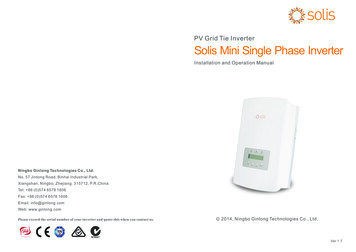
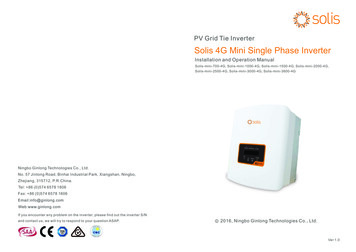
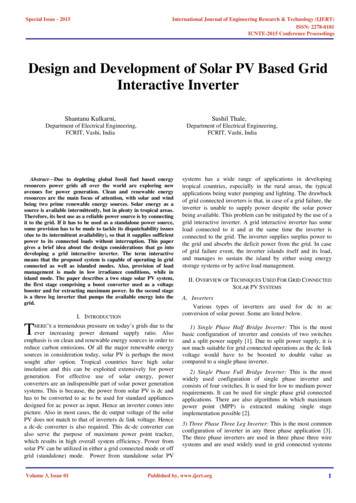
![Welcome [s3-ap-southeast-2.amazonaws ]](/img/28/wmi5140-user-manual.jpg)
